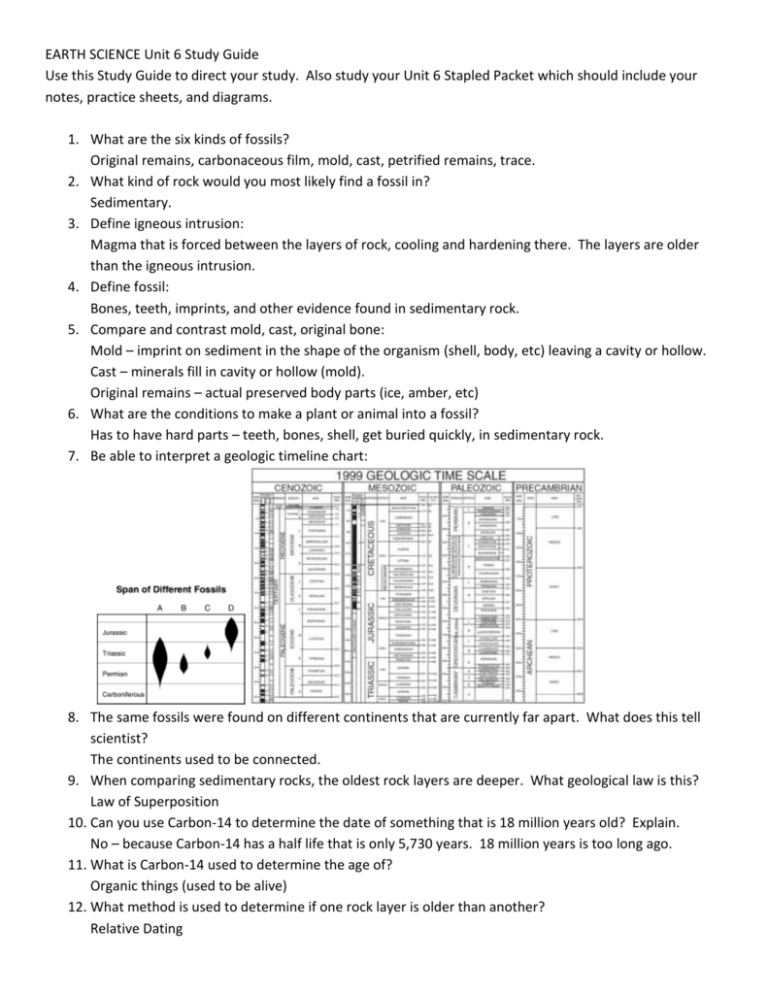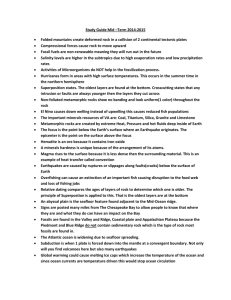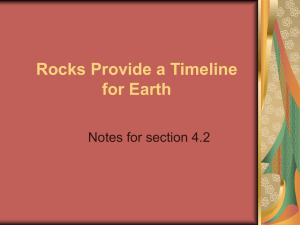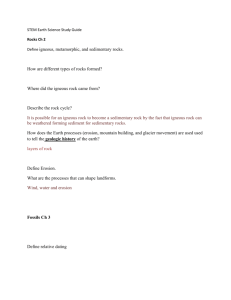EARTH SCIENCE Unit 6 Study Guide KEY
advertisement

EARTH SCIENCE Unit 6 Study Guide Use this Study Guide to direct your study. Also study your Unit 6 Stapled Packet which should include your notes, practice sheets, and diagrams. 1. What are the six kinds of fossils? Original remains, carbonaceous film, mold, cast, petrified remains, trace. 2. What kind of rock would you most likely find a fossil in? Sedimentary. 3. Define igneous intrusion: Magma that is forced between the layers of rock, cooling and hardening there. The layers are older than the igneous intrusion. 4. Define fossil: Bones, teeth, imprints, and other evidence found in sedimentary rock. 5. Compare and contrast mold, cast, original bone: Mold – imprint on sediment in the shape of the organism (shell, body, etc) leaving a cavity or hollow. Cast – minerals fill in cavity or hollow (mold). Original remains – actual preserved body parts (ice, amber, etc) 6. What are the conditions to make a plant or animal into a fossil? Has to have hard parts – teeth, bones, shell, get buried quickly, in sedimentary rock. 7. Be able to interpret a geologic timeline chart: 8. The same fossils were found on different continents that are currently far apart. What does this tell scientist? The continents used to be connected. 9. When comparing sedimentary rocks, the oldest rock layers are deeper. What geological law is this? Law of Superposition 10. Can you use Carbon-14 to determine the date of something that is 18 million years old? Explain. No – because Carbon-14 has a half life that is only 5,730 years. 18 million years is too long ago. 11. What is Carbon-14 used to determine the age of? Organic things (used to be alive) 12. What method is used to determine if one rock layer is older than another? Relative Dating 13. Where would you NOT find fossils in a cross section of rocks? Explain. Igneous intrusion – they would be destroyed 14. Which of these are MOST correct? YES here it is AGAIN! 15. Define index fossil: Type of fossil that is widespread over a large geographical range over a short time frame. 16. Why does seafloor spreading occur? Because of convection currents in the mantle AND molten material in the mantle rises to the surface. 17. Put the layers of rock in order from oldest to youngest: 18. Complete this table: Half-life Mass of original C-14 remaining (grams) Number of years 0 1 0 1 ½ 5700 2 ¼ 11,400 3 1/8 17,100 4 5 6 19. What is the best evidence that many different geological periods are represented in Virginia? Fossils from different geological ages are found in VA 20. What cities are located in the Chesapeake Bay Watershed? Hampton, Arlington, Charlottesville, Richmond, Newport News 21. Draw a transform boundary and label with these: asthenosphere, plate, transform 22. What are the coordinates for Virginia? 39 degrees N, 76 degrees W 23. Fossils of fish are found in the Blue Ridge Mountains. What does this tell you? The Blue Ridge is on top of an ancient marine environment. 24. Most of the fossils in Virginia are marine. Why? Virginia was covered with ocean in ancient times. 25. Compare ocean crust with continental crust: Ocean crust – thinner and denser Continental crust – thicker and less dense 26. What Virginia province is best known for Karst Topography? Valley & Ridge 27. What geological process is most associated with the Coastal Plains Province of Virginia? Erosion & deposition 28. Which Virginia province is rolling hills underlain by ancient igneous & metamorphic rocks? Piedmont 29. The bedrock of Virginia is basalt. What does this tell scientists? Ancient Virginia had a lot of volcanic activity (Basalt is an igneous rock). 30. Describe Virginia’s Coastal Plain Province (FYI underlain = beneath) Flat area made of young sediments with older crystalline rocks beneath 31. Describe Virginia’s Piedmont Province: Rolling hills underlain with ancient igneous & metamorphic rocks beneath 32. Describe Virginia’s Blue Ridge Province: High ridge of billion-year-old igneous & metamorphic rock 33. Describe Virginia’s Valley & Ridge Province: Area of long, parallel ridges & valleys with ancient folded, faulted sedimentary rocks beneath 34. Describe Virginia’s Appalachian Plateau Province: Area underlain with ancient, flat-lying sedimentary rocks containing most of Virginia’s coal resources 35. What is the best way to figure out how long it took a thick layer of sedimentary rock to form? Calculate the age of the top and the bottom edges of the layer 36. What element is most often used to determine the age of ancient rocks? Explain Uranium, because it has a very long half-life. 37. What are the most important facts to remember about absolute dating? It is also called radiometric or radiocarbon Carbon-14 decay is only measurable to 60,000 years Radioactive material decays at a constant rate Radiocarbon dating is used for organic (used to be alive, therefore is carbon-based) material 38. Define half-life: Half-life is how long it takes ½ the mass of a sample of radioactive material to decay into a new substance. 39. Look at these cross sections of rocks. Where is the oldest? Where is the youngest? What rule can you use to support your answers? 40. What is the best indication of the relative age of a rock layer? The position of the layer when compared to surrounding layers 41. What the method of determining the age of fossils using the radioactive decay of material called? Absolute dating 42. What is the geological law called that says that the youngest sedimentary rocks will be found on the top layer? Law of superposition 43. The approximate age of rock layers and fossils can be determined by combining what dating techniques? Relative dating and absolute dating 44. Label the Physiographic Provinces of Virginia: 45. The coastal plains were formed by what part of the WED process? Deposition









